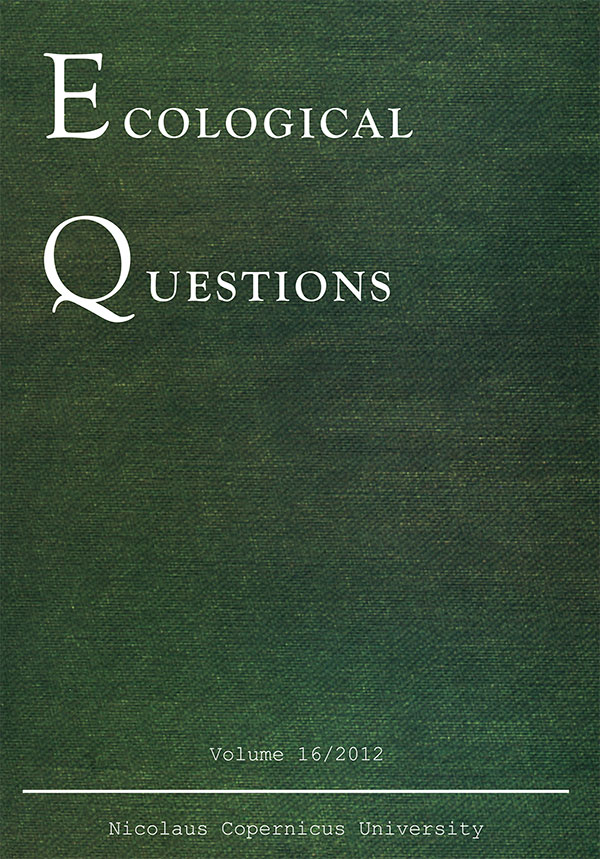Characteristics of sedimentary environments in brackish marsh soils in relation to organic matter properties (Puck Lagoon, Northern Poland)
DOI:
https://doi.org/10.12775/v10090-012-0009-zKeywords
brackish marsh soils, soil organic matter, Baltic Sea, soil genesis, Beka reserve, plant macroremainsAbstract
The research focused on brackish marsh soils located within the coastal zone of Puck Lagoon (the Beka botanical and ornithological nature reserve). They are characterised by the presence of layers rich with allochthonous organic matter, derived from washing out of peat deposits. The objective of the research was to determine sedimentary environments of the soil organic matter based on selected properties. The obtained results indicated that despite similar morphological characteristics, these soils might have developed in slightly different environmental conditions, determined mostly by the Baltic water levels and morphology of the coast. The organic matter of the studied soils was characterised by relatively low aromaticity, which may indicate the ongoing process of decomposition. The presence of both peat-bog, rush and ruderal plants, as well as trees in the species composition of macroremains proved the heterogeneity of sedimentary environments and confirmed the allochthonous origin of organic matter accumulated in the studied brackish marsh soils.References
Beyer L., Cordsen E., Blume H.-P., Schleuss U., Vogt B. & Wu Q., 1996, Soil organic matter composition in urbic anthrosols in the city of Kiel, NW-Germany, as revealed by wet chemistry and CPMAS 13C-NMR spectroscopy of whole soil samples, Soil Technology 9: 121-132.[http://dx.doi.org/10.1016/S0933-3630(96)00007-4]
Błaszkowska B., Gerstmannowa E. & Narwojsz A., 1996, Środowisko fizyczno-geograficzne [Physical and geographical environment], [in:] Z. Lenartowicz (ed.), Monografia rezerwatu przyrody Beka [Monography of the Beka Reserve], Materiały do monografii przyrodniczej regionu gdańskiego, Wyd. Gdańskie, Gdańsk: 88-99.
Cyberski J. & Szefler K., 1993, Klimat Zatoki i jej zlewiska [Climate of the Bay and its catchment], [in:] K. Korzeniewski (ed.), Zatoka Pucka [Puck Bay], Instytut Oceanografii UG, Gdańsk: 14-39.
Drzymulska D., 2003, Znaczenie analizy subfosylnych makroszczątków roślinnych i stopnia rozkładu torfu dla rekonstrukcji paleośrodowiskowych [The importance of subfossil plant remnants and peat decomposition degree analyses for palaeoenvironment reconstruction], Kosmos 52 (2-3): 299-306.
Frey D. G., 1964, Remains of animals in quaternary lake and bog sediments and their interpretation, Archiv für Hydrobiologie 2: 1-114. Guidelines for Soil Description, 2006, Food and Agriculture Organization of the United Nations, Rome.
Hulisz P., 2007, Wybrane aspekty badań gleb zasolonych w Polsce [Selected aspects of salt-affected soil research in Poland], SOP, Toruń.
Hulisz P., 2011, Genesis, properties and systematic position of alluvial soils developed from sandy marine sediments (Beka, Gulf of Puck), [in:] M. Drewnik, A.
Kacprzak, W. Szymański (eds.), Historia i kierunki rozwoju geografii gleb w Polsce, UJ Kraków: 69.
IUSS Working Group WRB, 2007, World Reference Base for Soil Resources 2006, first update 2007, World Soil Resources Reports 103, FAO, Rome.
Jankowska H. & Łęczyński L., 1993, Charakterystyka brzegów zatoki na tle budowy geologicznej [Characteristics of shores of the bay on the background of the geological structure], [in:] Zatoka Pucka [Puck Bay], K. Korzeniewski (ed.), Instytut Oceanografii UG, Gdańsk: 303-308.
Jokiel J. & Woźniak E., 2012, Czasowe zmiany sytuacji hydrograficznej słonych obszarów podmokłych rezerwatu Beka [Temporal changes in the hydrographic situation in salt marshes of the Beka nature reserve], Inżynieria Ekologiczna 29: 57-65.
Kögel-Knabner J., 1997, 13C and 15N NMR spectroscopy as a tool in soil organic matter research, Geoderma 80: 243-270.[http://dx.doi.org/10.1016/S0016-7061(97)00055-4
Kornaś J., 1977, Analiza flor synantropijnych [Analysis of synanthropic flora], Wiad. Bot. 21: 85-91.
Kowalewski G., 2007, Analiza makroszczątkowa w badaniach paleolimnologicznych [Plant macroremain analysis in the palaeolimnological studiem], Studia Limnologica et Telmatica 1(1): 67-82.
Kramarska R., Uścinowicz S. & Zachowicz J., 1995, Origin and evolution of the Puck Lagoon, [in:] K. Rotnicki (ed.), Polish Coast: Past, Present and Future, Journal of Coastal Research, Special Issue: 187-191.
Nowacki J., 1993, Termika, zasolenie i gęstość wody [Thermals, salinity and density of water], [in:] K. Korzeniewski (ed.), Zatoka Pucka [Puck Bay], Instytut Oceanografii UG, Gdańsk: 79-111.
Podbielkowski Z. & Tomaszewicz H., 1996, Zarys hydrobotaniki [Outline of the hydrobotanics], PWN, Warszawa.
Pracz J., 1989, Właściwości gleb tworzących się przy udziale słonej wody gruntowej w polskiej strefie przybałtyckiej [Properties of soils formed under the influence of saline ground water in the region of the Polish Balic coast], Rozprawy naukowe i monografie, Wyd. SGGW-AR, Warszawa.
Pracz J. & Kwasowski W., 2005, Organiczne gleby słone występujące w rejonie Zatoki Puckiej [Organic saline soils from the area of the Puck Bay], Roczniki Gleboznawcze 46 (3/4): 89-99.
Santín C., González-Pérez M., Otero X. L., Vidal-Torrado P., Macías F. & Álvarez M. Á., 2008, Characterization of humic substances in salt marsh soils under sea rush (Juncus maritimus), Estuarine Coastal and Shelf Science 79(3): 541-548.[http://dx.doi.org/10.1016/j.ecss.2008.05.007]
Strzelecka J. & Gonet S. S., 2009, Effect of gamma irradiation on properties of soil humic acids, Polish Journal of Soil Science 42(2): 203-210.
Stuermer D. H. & Payne J. R., 1976, Investigation of seawater and terrestrial humic substances with carbon-13 and proton nuclear magnetic resonance, Geochimica et Cosmochimica Acta 40: 1109-1114.[http://dx.doi.org/10.1016/0016-7037(76)90052-1]
Systematics of Polish Soils, 5th edition [Systematyka Gleb Polski, Wydanie V], 2011, Marcinek J. & Komisarek J. (eds.), Roczniki Gleboznawcze 62 (3).
Urbański J. A. & Ślimak A., 2008, Assessing flood risk and detecting changes of salt water inflow in a coastal micro-tidal brackish marsh using GIS, Oceanological and Hydrobiological Studies 37(3): 3-20.
Uścinowicz S., 2006, A relative sea-level curve for the Polish Southern Baltic Sea, Quaternary International 145-146: 86-105.
Velichkevich F. Y. & Zastawniak E., 2006, Atlas of the Pleistocene vascular plant macrofossil of Central and Eastern Europe, Part 1 - Pteridopytes and monocotyledons, Kraków.
Wszałek-Rożek K. & Markowski R., 2010, Zróżnicowanie florystyczne zachodniego obrzeża Zatoki Puckiej (Północna Polska) [Floristic diversity of the west coast of Zatoka Pucka (northern Poland)], Acta Botanica Cassubica 7-9: 55-78.
Downloads
Published
How to Cite
Issue
Section
Stats
Number of views and downloads: 597
Number of citations: 0



